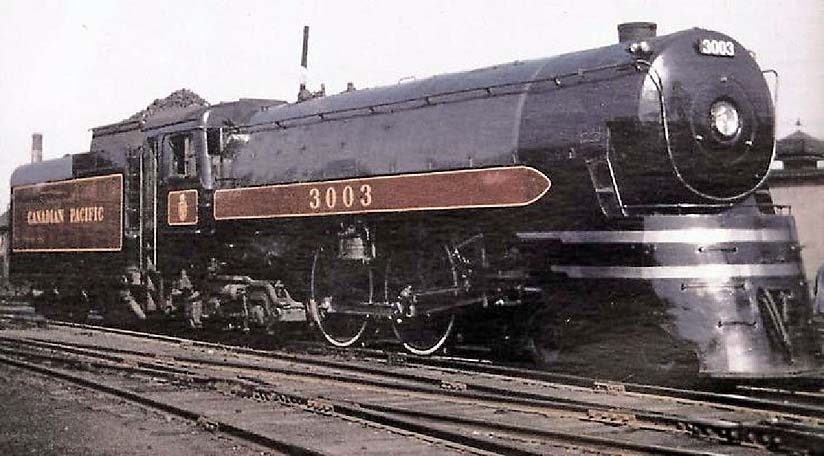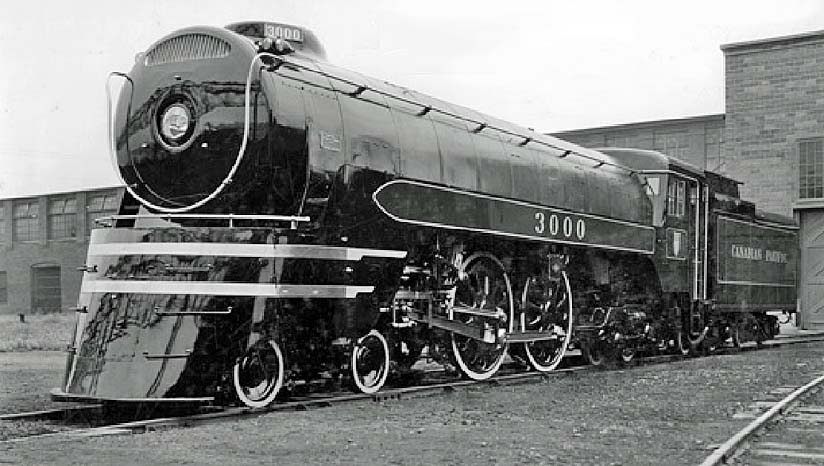
Canada - No sooner had man invented motive power, than the quest began for who could achieve the fastest speed, on land, in the air,
and on water.
When it came to railways, Canada briefly was in world record speed territory.
In the mid thirties, the Canadian Pacific Railway (CP) began exploring a new concept for a fast passenger train to revive interest in inter-city rail
travel.
By 1935 CP had built air-conditioned four car trains to be pulled by their new lightweight 4-4-4 F2 locomotive series. numbered 3000 to 3004.

Two would operate on the Montreal-Quebec City run, two for Toronto- Windsor, and one to the Calgary-Edmonton service.
These were dubbed "Jubilee" class locomotives to denote 50 years of transcontinental passenger service by CP.
A similar 4-4-4 series, slightly shorter with smaller drive wheels was also dubbed Jubilee, and built the next year were known as F1 and in the 2000 numerical
series.
The F2 3000 series Jubilee's had big 80 inch drive wheels, were semi-streamlined, and operated at an unusually high boiler pressure of 300 psi.
In July 1936 the first of the F2 Jubilees rolled out of the Montreal Locomotive Works (MLW), which would cease building engines during the war to become a
builder of Ram tanks, and the Sexton self-propelled gun.

It was on this date in 1936 (some sources say 1937) that number 3003 set a Canadian steam locomotive speed record while apparently on an air brake test
run.
While pulling the special four car train on CP's Winchester Subdivision between Smith's Falls Ontario, and Montreal, 3003 hits an officially recorded speed of
112.5 mph near St-Telesphore, Quebec.
The engine's high speed ability couldn't save steam however.
By the early 1950's, diesel, cheaper to operate, was clearly taking over.
By the mid 1950's most steam loco's had begun to be replaced.
Budd cars, self propelled passenger cars, also took their toll on the shorter intercity runs.
Apparently none of the 3000's survive.
It seems some confusion between Montreal and Calgary about which one was to preserve the last example meant that both surviving F2's were scrapped in
1957.
It is interesting to note that the locomotive speed record remained in Canada until 1974 when broken by a diesel engine and soon after by the somewhat
short-lived and troubled high speed turbo trains.
Even today it is rare that passenger trains in Canada reach 100 mph and only on a few limited stretches of track.
The fastest speed on record for a steam locomotive goes to Britain's magnificent "Mallard" a highly streamlined engine that briefly achieved 125.88
on a slight downgrade in July of 1938.
Marc Montgomery.
(because there was no image with original article) *2. Original news article image replaced.
(usually because it's been seen before)
provisions in Section 29 of the Canadian
Copyright Modernization Act.

